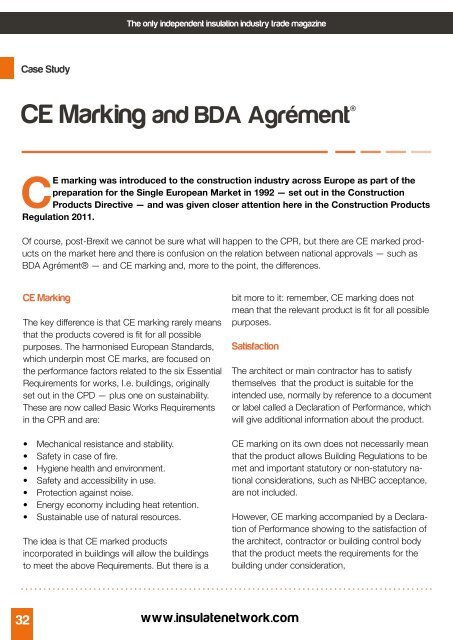Insulate Magazine Issue 10
Create successful ePaper yourself
Turn your PDF publications into a flip-book with our unique Google optimized e-Paper software.
The only independent insulation industry trade magazine<br />
www.insulatenetwork.com<br />
Case Study<br />
CE Marking and BDA Agrément®<br />
CE marking was introduced to the construction industry across Europe as part of the<br />
preparation for the Single European Market in 1992 — set out in the Construction<br />
Products Directive — and was given closer attention here in the Construction Products<br />
Regulation 2011.<br />
Of course, post-Brexit we cannot be sure what will happen to the CPR, but there are CE marked products<br />
on the market here and there is confusion on the relation between national approvals — such as<br />
BDA Agrément® — and CE marking and, more to the point, the differences.<br />
CE Marking<br />
The key difference is that CE marking rarely means<br />
that the products covered is fit for all possible<br />
purposes. The harmonised European Standards,<br />
which underpin most CE marks, are focused on<br />
the performance factors related to the six Essential<br />
Requirements for works, I.e. buildings, originally<br />
set out in the CPD — plus one on sustainability.<br />
These are now called Basic Works Requirements<br />
in the CPR and are:<br />
bit more to it: remember, CE marking does not<br />
mean that the relevant product is fit for all possible<br />
purposes.<br />
Satisfaction<br />
The architect or main contractor has to satisfy<br />
themselves that the product is suitable for the<br />
intended use, normally by reference to a document<br />
or label called a Declaration of Performance, which<br />
will give additional information about the product.<br />
will be acceptable under Building Regulations.<br />
BDA Agrément®<br />
A BDA Agrément® addresses the different<br />
Building Regulations applicable to each part of<br />
the United Kingdom and NHBC criteria are also<br />
considered – in a single document.<br />
Durability is another key factor not addressed by<br />
CE marking but every BDA Agrément® contains<br />
a durability statement — vitally important information<br />
for architects, developers and building owners,<br />
letting them know how long the product is<br />
likely to last. Installation information is also absent<br />
from CE marking but there are installation details<br />
in all BDA Agréments.<br />
initial type testing and a management<br />
systems certification by a body notified for that<br />
purpose to the European Commission. Only<br />
products with key health and safety<br />
considerations need the involvement of a<br />
product certification body before CE marking<br />
can be applied.<br />
Kiwa BDA<br />
With all products approved by Kiwa BDA, testing<br />
is undertaken and the resulting data assessed<br />
by our experts, and if the approval is awarded<br />
the manufacturer is subject to continuing surveillance<br />
by our inspectors throughout the validity of<br />
the approval. This means specifiers, users and<br />
building owners can have total confidence that all<br />
products with a BDA Agrément® will be — and<br />
perform — exactly as set out in the document.<br />
A BDA Agrément® addresses the<br />
different Building Regulations applicable<br />
to each part of the United<br />
Kingdom and NHBC criteria are also<br />
considered – in a single document.<br />
• Mechanical resistance and stability.<br />
• Safety in case of fire.<br />
• Hygiene health and environment.<br />
• Safety and accessibility in use.<br />
• Protection against noise.<br />
• Energy economy including heat retention.<br />
• Sustainable use of natural resources.<br />
The idea is that CE marked products<br />
incorporated in buildings will allow the buildings<br />
to meet the above Requirements. But there is a<br />
CE marking on its own does not necessarily mean<br />
that the product allows Building Regulations to be<br />
met and important statutory or non-statutory national<br />
considerations, such as NHBC acceptance,<br />
are not included.<br />
However, CE marking accompanied by a Declaration<br />
of Performance showing to the satisfaction of<br />
the architect, contractor or building control body<br />
that the product meets the requirements for the<br />
building under consideration,<br />
Surveillance and inspection vary in CE marking<br />
depending on the nature of the product and its<br />
role in the building; the more health and safety<br />
critical, the more onerous the regime. At the<br />
lower end of the scale the manufacturer or importer<br />
can simply declare that the relevant product<br />
complies with the Standard and apply the CE<br />
mark, with no continuing surveillance.<br />
Most products will be CE marked on the basis of<br />
32 www.insulatenetwork.com<br />
insulatenetwork<br />
33
















